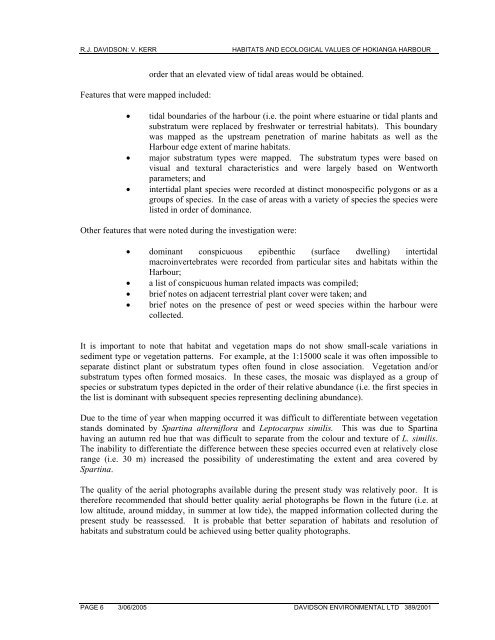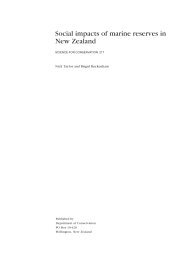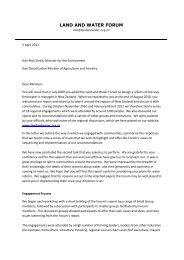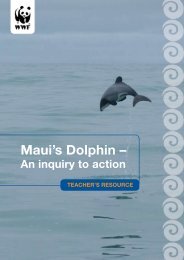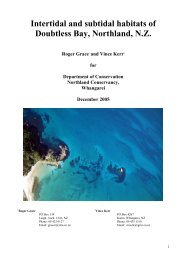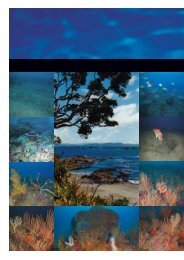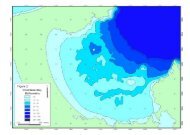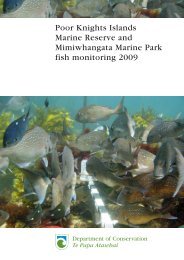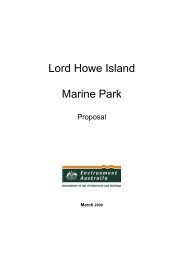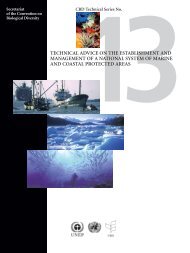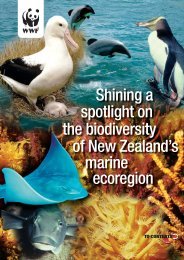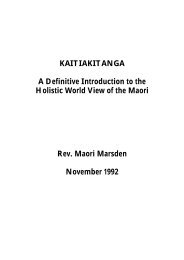Habitats and Ecological Values of the Hokianga ... - MarineNZ.org.nz
Habitats and Ecological Values of the Hokianga ... - MarineNZ.org.nz
Habitats and Ecological Values of the Hokianga ... - MarineNZ.org.nz
Create successful ePaper yourself
Turn your PDF publications into a flip-book with our unique Google optimized e-Paper software.
R.J. DAVIDSON: V. KERR<br />
HABITATS AND ECOLOGICAL VALUES OF HOKIANGA HARBOUR<br />
Features that were mapped included:<br />
order that an elevated view <strong>of</strong> tidal areas would be obtained.<br />
• tidal boundaries <strong>of</strong> <strong>the</strong> harbour (i.e. <strong>the</strong> point where estuarine or tidal plants <strong>and</strong><br />
substratum were replaced by freshwater or terrestrial habitats). This boundary<br />
was mapped as <strong>the</strong> upstream penetration <strong>of</strong> marine habitats as well as <strong>the</strong><br />
Harbour edge extent <strong>of</strong> marine habitats.<br />
• major substratum types were mapped. The substratum types were based on<br />
visual <strong>and</strong> textural characteristics <strong>and</strong> were largely based on Wentworth<br />
parameters; <strong>and</strong><br />
• intertidal plant species were recorded at distinct monospecific polygons or as a<br />
groups <strong>of</strong> species. In <strong>the</strong> case <strong>of</strong> areas with a variety <strong>of</strong> species <strong>the</strong> species were<br />
listed in order <strong>of</strong> dominance.<br />
O<strong>the</strong>r features that were noted during <strong>the</strong> investigation were:<br />
• dominant conspicuous epibenthic (surface dwelling) intertidal<br />
macroinvertebrates were recorded from particular sites <strong>and</strong> habitats within <strong>the</strong><br />
Harbour;<br />
• a list <strong>of</strong> conspicuous human related impacts was compiled;<br />
• brief notes on adjacent terrestrial plant cover were taken; <strong>and</strong><br />
• brief notes on <strong>the</strong> presence <strong>of</strong> pest or weed species within <strong>the</strong> harbour were<br />
collected.<br />
It is important to note that habitat <strong>and</strong> vegetation maps do not show small-scale variations in<br />
sediment type or vegetation patterns. For example, at <strong>the</strong> 1:15000 scale it was <strong>of</strong>ten impossible to<br />
separate distinct plant or substratum types <strong>of</strong>ten found in close association. Vegetation <strong>and</strong>/or<br />
substratum types <strong>of</strong>ten formed mosaics. In <strong>the</strong>se cases, <strong>the</strong> mosaic was displayed as a group <strong>of</strong><br />
species or substratum types depicted in <strong>the</strong> order <strong>of</strong> <strong>the</strong>ir relative abundance (i.e. <strong>the</strong> first species in<br />
<strong>the</strong> list is dominant with subsequent species representing declining abundance).<br />
Due to <strong>the</strong> time <strong>of</strong> year when mapping occurred it was difficult to differentiate between vegetation<br />
st<strong>and</strong>s dominated by Spartina alterniflora <strong>and</strong> Leptocarpus similis. This was due to Spartina<br />
having an autumn red hue that was difficult to separate from <strong>the</strong> colour <strong>and</strong> texture <strong>of</strong> L. similis.<br />
The inability to differentiate <strong>the</strong> difference between <strong>the</strong>se species occurred even at relatively close<br />
range (i.e. 30 m) increased <strong>the</strong> possibility <strong>of</strong> underestimating <strong>the</strong> extent <strong>and</strong> area covered by<br />
Spartina.<br />
The quality <strong>of</strong> <strong>the</strong> aerial photographs available during <strong>the</strong> present study was relatively poor. It is<br />
<strong>the</strong>refore recommended that should better quality aerial photographs be flown in <strong>the</strong> future (i.e. at<br />
low altitude, around midday, in summer at low tide), <strong>the</strong> mapped information collected during <strong>the</strong><br />
present study be reassessed. It is probable that better separation <strong>of</strong> habitats <strong>and</strong> resolution <strong>of</strong><br />
habitats <strong>and</strong> substratum could be achieved using better quality photographs.<br />
PAGE 6 3/06/2005 DAVIDSON ENVIRONMENTAL LTD 389/2001


